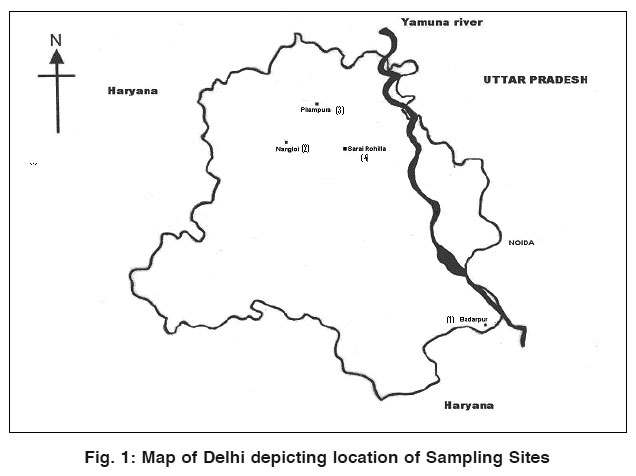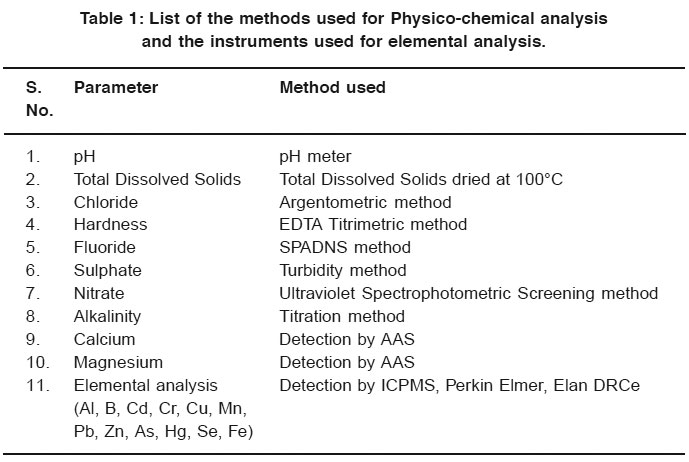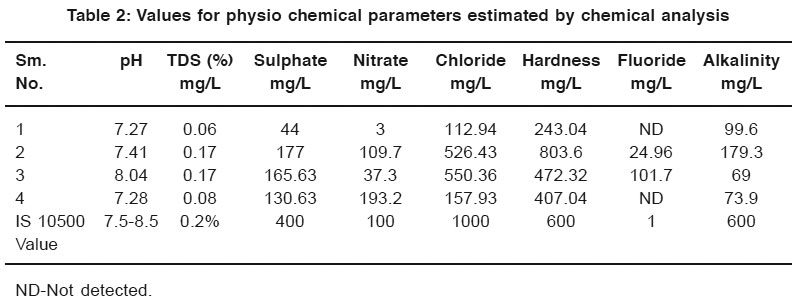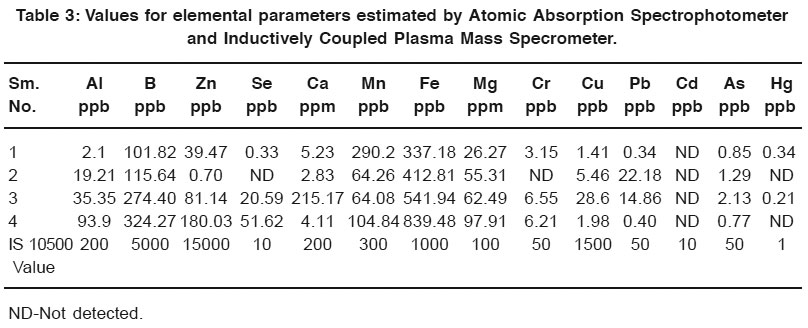Physio-chemical and elemental analysis of ground water of four locations of Delhi
Shikha Bisht1 * and B.A. Patra2
1
Galgotias College of Engineering and Technology,
Greater Noida,
201 306
India
2
Thermo Fisher Scientific,
Thermo Electron LLS India Pvt. Ltd,
Mumbai,
400 076
India
DOI: http://dx.doi.org/10.12944/CWE.4.2.19
Physico-chemical and elemental studies of four ground water (bore wells) samples from different parts of Delhi was carried out during the month of April-May. The water quality parameters like pH, Total dissolved solids (TDS), Total alkalinity (TA), Total hardness (TH), Chloride (Cl-), Sulphate (SO42), Nitrate (NO3-), Fluoride (F-), Calcium (Ca2+), Magnesium (Mg2+), Aluminium (Al), Boron (B), Zinc (Zn), Selenium (Se), Manganese (Mn), Iron (Fe), Chromium (Cr), Copper (Cu), Lead (Pb), Cadmium (Cd), Arsenic (As) and Mercury (Hg) were studied and out come of the results were discussed. The elemental analysis was carried out by usage of ICPMS. Different parameters were examined & compared with Indian Standards, BIS 10500 (Maximum Permissible Value) to determine their suitability for drinking purposes.
Copy the following to cite this article:
Bisht S, Patra B.A. Physio-chemical and elemental analysis of ground water of four locations of Delhi. Curr World Environ 2009;4(2):389-392 DOI:http://dx.doi.org/10.12944/CWE.4.2.19
Copy the following to cite this URL:
Bisht S, Patra B.A. Physio-chemical and elemental analysis of ground water of four locations of Delhi. Curr World Environ 2009;4(2):389-392. Available from: http://www.cwejournal.org/?p=992
Download article (pdf)
Citation Manager
Publish History
Select type of program for download
| Endnote EndNote format (Mac & Win) | |
| Reference Manager Ris format (Win only) | |
| Procite Ris format (Win only) | |
| Medlars Format | |
| RefWorks Format RefWorks format (Mac & Win) | |
| BibTex Format BibTex format (Mac & Win) |
Article Publishing History
| Received: | 2009-06-10 |
|---|---|
| Accepted: | 2009-10-01 |
Introduction
Delhi, situated at the bank of Yamuna river, between the latitudes 280 12' -280 53' N and the longitudes 760 50'- 770 23', is one of the important business centers of India and thickly populated as well¹. Average water consumption in Delhi is estimated at being 240 liters per capita per day (lpcd), the highest in the country². This demand for drinking water is supplied by the Delhi Jal Board and is wholly provided or partially substituted by the available ground water of the area. Although the water supplied is normally tested for its suitability for drinking, ground water is accepted as such by the residents without an investigation of its potential for usage.
Any foreign matter contaminates water, which may be either natural or artificial. Inorganic materials, such as acids, salts, nitrates and chlorides that normally are not toxic at low concentrations may become concentrated enough to lower water quality or adversely affect biological communities3. Potential sources of contamination of water during pumping include leachates and corrosion products from pipe materials, pipe linings and organic substances able to permeate through plastic pipe materials laid after boring4. The underground water is also threatened with pollution from seepage pits, refuse dumps, septic tanks, barnyard manures, transport accidents, and with diverse agricultural, chemical or biological pollutants5.
In this study, attempt has been made to investigate the quality of water at 4 locations in Delhi to determine its quality. These locations have been selected randomly.
Material and Methods
Standard methods of collection, preservation and analysis were adopted (6). Grab sampling method was used for the collection of 4 Ground water samples used for drinking from the city (Figure 1). The analysis of Physio chemical parameters was done by procedure adopted from Standard Methods: APHA (6) and the elemental analysis were done using ICPMS (Inductively Coupled Plasma Mass Spectrometer, PERKIN ELMER, Elan DRCe).
 |
Figure 1: Map of Delhi depicting location of Sampling Sites Click here to view table |
Results and Discussion
Sample 1, Groundwater from Badarpur
All the Physio chemical parameters were within the permissible range by IS 10500 standards. Similarly elemental parameters depicted conformity with the IS 10500 prescribed standards. The water can therefore be used for drinking purposes after chlorination.
Sample 2, Groundwater from Nangloi
The pH of the water sample collected from Nangloi was 7.41.The water sample collected from Nangloi depicted on analysis all Physico-chemical parameters to be under the IS 10500 prescribed limit for drinking purposes with the exception of nitrate, hardness and fluoride. They are found to exceed the IS prescribed limit of 100 ppm, 600 ppm and 1 ppm respectively.
A high level of hardness indicates the presence of salts in water and thereby changes its palatability, consequently reducing its acceptability for drinking. A high level of hardness (above 300 ppm) also leads to scale formation in water supply structures and boilers (7), whereas ver y low hardness in water can lead to corrosion of pipelines (8). A high concentration of hardness may be due to leaching of minerals from the soils (9).
Conversely the elemental characteristics for all the parameters considered were found to be under the guidelines prescribed by IS for drinking. This water could be therefore considered safe for drinking purposes after treatment for Nitrate, Hardness and fluoride.
Sample 3, Groundwater from Pitampura
The pH of the water sample collected from Pitampura was slightly alkaline (8.04).The water sample collected from Nangloi depicted on analysis all Physico-chemical parameters to be under the IS 10500 prescribed limit for drinking purposes with the exception of fluoride. The level of fluoride was found to be highest among all the samples tested and was found to exceed the IS prescribed limit of 1 ppm.
Fluoride combines with the hydrochloric acid of stomach and leads to the formation of hydrogen fluoride which is highly corrosive (9). Fluoride is released into the ground water through weathering of primary silicates and associated accessory minerals (10).
The elemental characteristics depicted conformity with the IS standards with the exception of selenium (20.59 ppb) and calcium (215.17 ppm). They exceeded the prescribed standards of 10 ppb and 200 ppm respectively.
Sample 4, Groundwater from Sarai Rohilla
The water sample collected from Sarai Rohilla depicted on analysis an elevated concentration of nitrate (193.2 ppm), highest among all samples tested. All other Physico-chemical parameters were found to be under the IS 10500 prescribed limit for drinking purposes. Nitrate has long been associated with the occurrence of blue baby disease in infants or infantile methaemoglobinaemia which is caused due to bacterial reduction of nitrate into nitrite in stomach (11). Such high concentration of nitrate in drinking water may be attributed to the leaching of products of organic material biodegradation into the water sources.
Conversely, the elemental analysis depicted an elevated concentration of selenium. Selenium is an element needed by humans and other animals in small amounts, but in larger amounts can cause damage to the nervous system, fatigue, and irritability (2). This water therefore requires treatment.
 |
Table 1: List of the methods used for Physico-chemical analysis and the instruments used for elemental analysis. Click here to view table |
 |
Table 2: Values for physio chemical parameters estimated by chemical analysis Click here to view table |
 |
Table 3: Values for elemental parameters estimated by Atomic Absorption Spectrophotometer and Inductively Coupled Plasma Mass Specrometer. Click here to view table |
Acknowledgements
The analysis was carried out in ARBRO Analytical Division, New Delhi.
References
- Rajan M. R, Paneerselvam I., Indian J. Environ. and Ecoplan,(2005) 10(3), 771-776.
- Goel P. K, Water pollution Causes, Effects and Control, Second Edition, New Age International, New Delhi,(2006) 132-134.
- Cunningham William P, Cunningham Mary Ann, Principles of Environmental Science, Inquiries and Applications, Tata McGraw-Hill, New Delhi,(2004) 240.
- Cunningham William P, Saigo, Environmental science, Tata McGraw-Hill, New Delhi, Fifth Edition,(2004) 411-450.
- Agrawal K. C, Environmental pollution causes, effects and controls, Nidhi Publisher, Bikaner,(2001) 56-83.
- Standard methods for the examination of water and wastewater, American Public Health Association, NW, DC 20036,(1994) Pg 2:26-2:29, 2:36-2:39, 2:54-2:56, 4:53-4:56, 4:66-4:68, 4:79-4:83, 4:86-4:91, 4:114-4:115,4:176-4:179.
- Joseph Benny, Environmental Studies, Tata McGraw-Hill, Second Edition, New Delhi,(2009) 136.
- Manjunath D. L., Environmental Studies, Dorling Kindersley (India) Pvt. Ltd, Delhi,(2008) 26.
- Tiwari A. K., Dikshit R. P., Tripathi I. P. and Chaturvedi S. K., Indian J. Environmental Protection,(2003) 23(9), 1045-1050.
- Thakare S. B., Parvate A. V. and Rao M., Indian J. Environ. and Ecoplan,(2005) 10(3), 657-661.
- Kaushik Anubha and Kaushik C. P. Environmental Studies, Second Edition, New Age International (P) Limited, New Delhi,(2006) 135.






